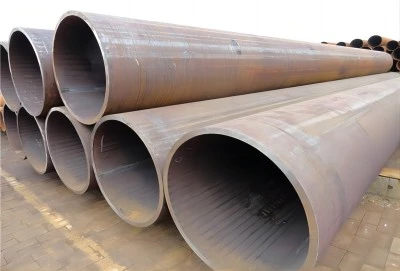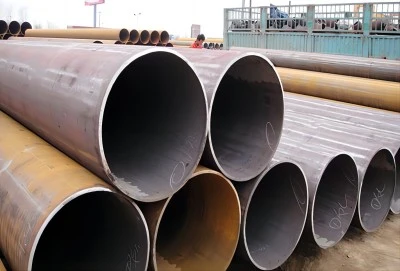Double Submerged Arc Welded (DSAW) steel pipes are crucial components in various industries, including oil and gas, construction, and infrastructure development. Understanding the standard size ranges, specifications, and commonly used sizes of DSAW steel pipes is essential for engineers, project managers, and procurement specialists.
|
|
|
What are the standard size ranges for DSAW steel pipes?
DSAW steel pipes are available in a wide range of sizes to accommodate diverse project requirements. The standard size ranges for DSAW steel pipes typically include:
- Outer Diameter (OD): 16 inches (406.4 mm) to 100 inches (2540 mm)
- Wall Thickness: 0.250 inches (6.35 mm) to 2 inches (50.8 mm)
- Length: Up to 80 feet (24.4 meters) for straight pipes
It's important to note that these ranges can vary depending on the manufacturer and specific industry standards. For instance, some producers may offer DSAW pipes with outer diameters as small as 8 inches (203.2 mm) or as large as 120 inches (3048 mm).
The American Petroleum Institute (API) provides specifications for DSAW steel pipes used in the oil and gas industry. According to API 5L, DSAW pipes can be manufactured in sizes ranging from NPS 16 (16 inches OD) to NPS 80 (80 inches OD) and beyond, with wall thicknesses varying based on the pipe grade and intended application.
How do wall thickness and diameter affect DSAW pipe specifications?
Wall thickness and diameter are crucial factors that influence DSAW pipe specifications and performance. These parameters directly impact the pipe's strength, pressure-bearing capacity, and suitability for specific applications.
1.Wall Thickness:
The wall thickness of DSAW steel pipes is typically expressed in inches or millimeters. It plays a vital role in determining the pipe's pressure rating, mechanical strength, and weight. Thicker walls generally provide:
- Higher pressure resistance
- Increased structural integrity
- Better resistance to external loads and environmental factors
However, thicker walls also result in heavier pipes, which can impact transportation and installation costs. The selection of wall thickness depends on factors such as operating pressure, environmental conditions, and safety requirements.
2.Diameter:
The diameter of DSAW steel pipes, usually measured as the outer diameter (OD), affects various aspects of pipe performance and application:
- Flow capacity: Larger diameters allow for higher flow rates
- Pressure rating: For a given wall thickness, larger diameters generally have lower pressure ratings
- Installation considerations: Pipe diameter influences handling, transportation, and installation methods
The relationship between wall thickness and diameter is often expressed as the Diameter to Thickness (D/t) ratio. This ratio is crucial in determining the pipe's resistance to external pressure and its overall structural stability.
When specifying DSAW steel pipes, it's essential to consider both wall thickness and diameter in conjunction with other factors such as steel grade, operating conditions, and industry standards. The American Society of Mechanical Engineers (ASME) provides guidelines for calculating the required wall thickness based on design pressure, allowable stress, and other factors in their B31 series of standards.
What are the most commonly used DSAW pipe sizes in the industry?
While DSAW steel pipes are available in a wide range of sizes, certain dimensions are more commonly used across various industries. Some of the most frequently encountered DSAW pipe sizes include:
- 24-inch OD (609.6 mm): Commonly used in water transmission and oil pipelines
- 30-inch OD (762 mm): Popular in natural gas transmission and offshore pipelines
- 36-inch OD (914.4 mm): Widely used in large-scale oil and gas transportation projects
- 42-inch OD (1066.8 mm): Frequently employed in high-capacity gas pipelines
- 48-inch OD (1219.2 mm): Used in major water transmission systems and large-diameter pipelines
These sizes are popular due to their balance of capacity, strength, and cost-effectiveness. However, the choice of pipe size depends on various factors, including:
- Project requirements
- Flow rate and pressure needs
- Environmental conditions
- Regulatory standards
- Economic considerations
In the oil and gas industry, the selection of DSAW pipe sizes is often guided by standards such as API 5L, which provides specifications for line pipe used in transportation systems. The choice of pipe size and wall thickness is critical in ensuring the safe and efficient operation of pipeline systems [3].
For water transmission projects, organizations like the American Water Works Association (AWWA) provide guidelines on pipe sizing and selection. AWWA C200 standard covers steel water pipe 6 inches (150 mm) and larger, including DSAW pipes, and offers guidance on determining appropriate pipe dimensions based on hydraulic requirements and structural considerations.
Contact Longma Group
Understanding DSAW pipe sizes is crucial for selecting the right pipe for your project. From standard size ranges to the impact of wall thickness and diameter on pipe specifications, and the most commonly used sizes in the industry, this knowledge empowers you to make informed decisions in your pipe selection process.
At Longma Group, we pride ourselves on offering an extensive selection of high-quality DSAW (Double Submerged Arc Welded) steel pipes that are perfectly tailored to meet the diverse needs of your projects. Whether you're working on large-scale energy infrastructure, oil and gas pipelines, or industrial applications, our DSAW pipes are engineered for strength, durability, and long-term performance in even the most demanding environments.
Our DSAW steel pipes are crafted using cutting-edge manufacturing techniques, ensuring superior weld quality and consistent material properties throughout the entire pipe. These pipes are designed to handle high-pressure systems, resist corrosion, and maintain structural integrity over decades of service. Available in a wide range of sizes and specifications, from small to large diameters, Longma Group provides pipes suitable for everything from onshore and offshore pipelines to water transmission systems and construction projects.
Don't hesitate to reach out to us at info@longma-group.com for personalized advice and quotations. Let's work together to ensure the success of your next project with our premium DSAW pipes.














